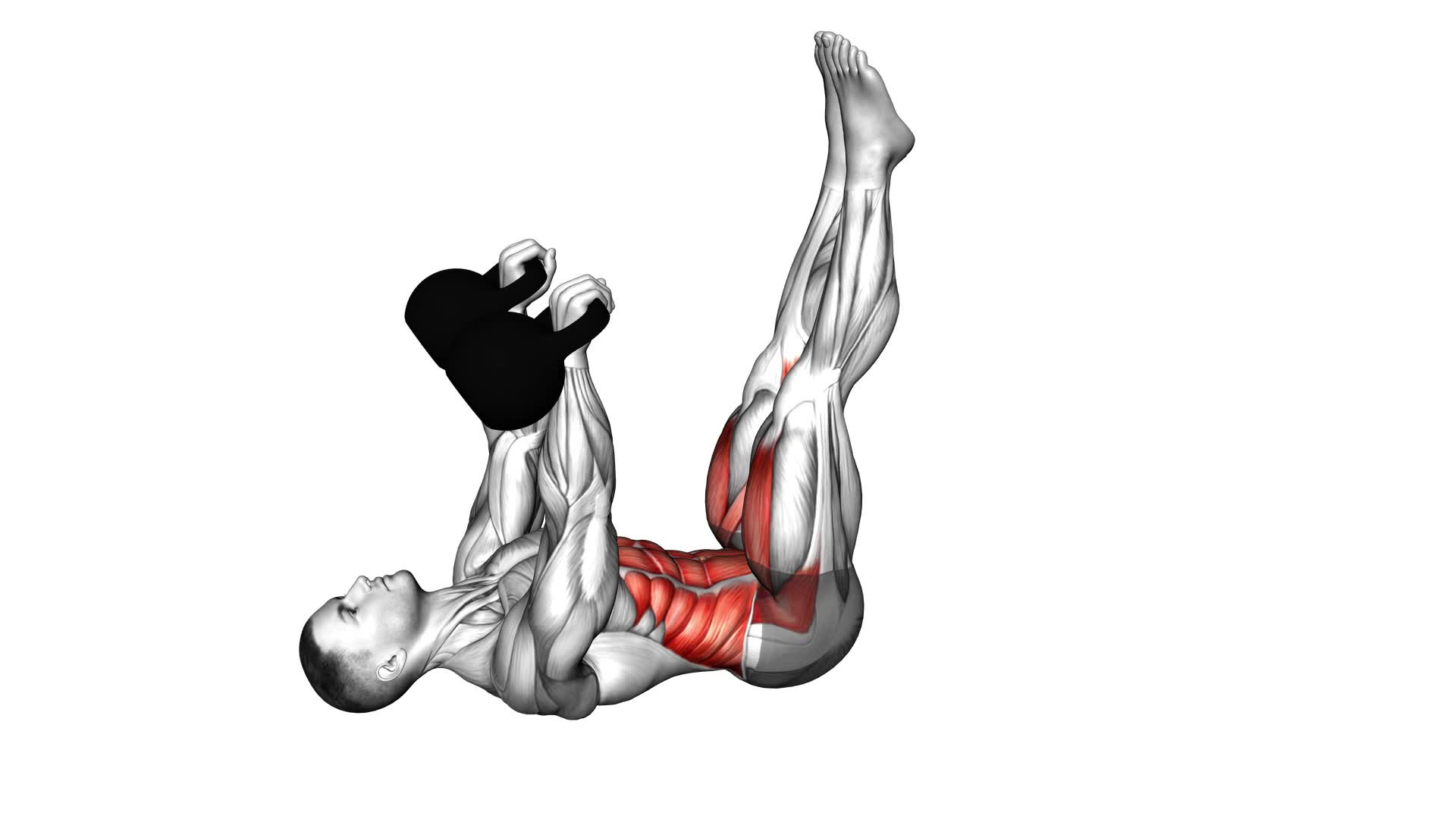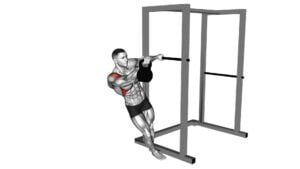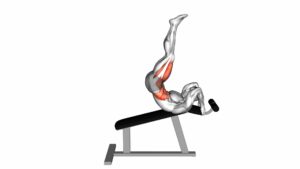Kettlebell Leg Raise (male) – Video Exercise Guide & Tips

Are you looking to strengthen your legs and improve your core stability? Look no further than the kettlebell leg raise exercise.
Watch This Exercise Video
In this video exercise guide, we'll show you the proper form and technique for this challenging exercise. Whether you're a beginner or advanced, we have variations and modifications to suit your fitness level.
Avoid common mistakes and maximize the effectiveness of this exercise with our expert tips.
Get ready to take your leg workout to the next level.
Key Takeaways
- Improved core strength and stability
- Avoid using momentum or swinging the kettlebell
- Prevent excessive arching of lower back
- Gradually increasing weight of kettlebell
Benefits of the Kettlebell Leg Raise
You will experience improved core strength and stability with the Kettlebell Leg Raise exercise. Compared to the traditional leg raise, the kettlebell leg raise offers unique benefits for enhancing your core strength.
One of the key advantages of the kettlebell leg raise is the added resistance provided by the kettlebell. By holding the kettlebell between your feet or ankles while performing the leg raise, you engage your core muscles even more intensely. This increased resistance challenges your core muscles to work harder, resulting in greater strength gains over time.
Additionally, the kettlebell leg raise requires a higher level of stability and control compared to the traditional leg raise. The uneven weight distribution of the kettlebell forces your core muscles to work harder to maintain balance and stability throughout the exercise. This not only strengthens your core muscles but also improves your overall stability and coordination.
Furthermore, incorporating kettlebell exercises into your core training routine offers numerous benefits for core strength. Kettlebell exercises are dynamic and require your core muscles to engage in multiple planes of motion. This helps to develop functional core strength that translates into improved performance in activities of daily living and sports.
Proper Form and Technique for the Exercise
To perform the kettlebell leg raise with proper form and technique, it's essential to engage your core throughout the exercise. This ensures that you're effectively targeting your abdominal muscles and maintaining stability.
Additionally, it's important to avoid common mistakes such as using momentum or swinging the kettlebell, as this can lead to improper form and potential injury.
Core Engagement Importance
Maintaining proper form and technique for the Kettlebell Leg Raise exercise requires active engagement of the core throughout the movement. Core stability plays a crucial role in this exercise as it helps to maintain balance and control.
By strengthening the lower abs, you can improve your ability to lift your legs while keeping your back flat on the ground. Engaging your core muscles during the Kettlebell Leg Raise exercise also helps to protect your spine and prevent any unnecessary strain.
To ensure proper engagement, focus on contracting your abs and drawing your belly button towards your spine as you lift your legs. Remember to breathe steadily and maintain control throughout the entire exercise to maximize the benefits for your core.
Common Mistakes to Avoid
To ensure proper form and technique for the Kettlebell Leg Raise exercise and avoid common mistakes, focus on maintaining core engagement throughout the movement.
One common mistake to avoid is allowing your lower back to arch excessively during the exercise. This can put unnecessary strain on your spine and decrease the effectiveness of the exercise. Instead, keep your pelvis tucked under and your core muscles activated to maintain a stable and neutral spine position.
Another mistake is using momentum to swing your legs up instead of relying on your core strength. Remember to control the movement using your abdominal muscles to lift your legs up and lower them back down in a controlled manner.
Variations and Modifications for Different Fitness Levels
Now let's explore the different variations and modifications you can incorporate into the kettlebell leg raise exercise to accommodate various fitness levels.
If you're a beginner, there are beginner-friendly modifications that can help you ease into the movement and build strength gradually.
On the other hand, for those who are more advanced, there are advanced variations that can challenge you further and take your workout to the next level.
Additionally, it's important to adapt the exercise to different abilities, making necessary adjustments to ensure safety and effectiveness.
Beginner-Friendly Modifications
Start by gradually increasing the weight of the kettlebell during your leg raises, as this will help you build strength and improve your fitness level. As a beginner, it's important to start with lighter weights and focus on proper form before progressing to heavier kettlebells. Here are some beginner-friendly modifications and scaling options to consider:
- Use a lighter kettlebell or start with bodyweight leg raises until you feel comfortable with the movement.
- Perform the leg raises with bent knees instead of straight legs to reduce the load on your core muscles.
- If the kettlebell feels too heavy, hold onto a stable object, such as a suspension trainer or a wall, for support and balance.
By starting with these modifications, you can gradually increase the intensity of your kettlebell leg raises as you build strength and confidence.
Now let's explore some advanced variations for pros.
Advanced Variations for Pros
As you progress to more advanced levels of fitness, there are a variety of advanced modifications and training techniques available for the kettlebell leg raise exercise. These variations cater to different fitness levels and provide new challenges to keep pushing your limits.
One advanced modification is the weighted kettlebell leg raise. In this variation, you hold a kettlebell between your feet while performing the leg raise. This adds extra resistance to the exercise, increasing the difficulty and targeting your core and hip flexors even more.
Another advanced training technique is the single-leg kettlebell leg raise. Instead of using both legs, you perform the exercise with one leg at a time. This requires more stability and strength, engaging your muscles in a different way.
For an even greater challenge, you can try the hanging kettlebell leg raise. Using a pull-up bar or suspension trainer, you hang from your hands while raising your legs with the kettlebell. This variation not only works your core but also strengthens your grip and upper body.
Remember to always start with proper form and gradually increase the difficulty as you become comfortable with each variation. By incorporating these advanced modifications and training techniques, you can take your kettlebell leg raise to the next level and continue to improve your overall fitness.
Adapting for Different Abilities
To adapt the kettlebell leg raise exercise for different fitness levels, you can incorporate variations and modifications that cater to individual abilities. Here are some strategies to consider:
- Different equipment options:
- Start with a lighter kettlebell or no kettlebell at all for beginners.
- Gradually increase the weight of the kettlebell as your strength and stability improve.
- Use a resistance band or ankle weights to add resistance for more advanced individuals.
- Progression strategies:
- Begin with bent knees if straightening the legs is too challenging.
- Focus on mastering the movement with proper form before progressing to more difficult variations.
- Incorporate tempo changes, such as slowing down the lowering phase, to increase the difficulty.
Common Mistakes to Avoid
Avoid arching your back excessively during the kettlebell leg raise exercise. One of the most common mistakes people make is allowing their lower back to round or arch too much, which can put strain on the spine and decrease the effectiveness of the exercise.
To maintain proper technique, focus on engaging your core muscles and keeping your back in a neutral position throughout the movement. Another mistake to avoid is using momentum to lift your legs instead of relying on your abdominal muscles. This can cheat the exercise and prevent you from fully engaging your core. Instead, focus on using controlled movements and actively contracting your abs to lift your legs.
Lastly, be mindful of the height at which you raise your legs. Raising them too high can cause your lower back to arch and put unnecessary strain on your spine. Aim to lift your legs to a height where you can maintain proper form and control.
By avoiding these common mistakes, you can maximize the effectiveness of the kettlebell leg raise exercise.
Now, let's move on to some tips for further enhancing the benefits of this exercise.
Tips for Maximizing the Effectiveness of the Exercise
Engage your core and focus on controlled movements to maximize the effectiveness of the kettlebell leg raise exercise. To get the most out of this exercise and achieve optimal results, consider the following tips:
- Choose the right kettlebell weight: Start with a weight that challenges you but still allows you to maintain proper form and control throughout the movement. Gradually increase the weight as you become stronger and more comfortable.
- Maintain proper form: Keep your back straight and shoulders relaxed throughout the exercise. Avoid swinging your legs or using momentum to lift the kettlebell. This will ensure that you're targeting the muscles in your core and legs effectively.
- Incorporate exercise modifications: If you find it difficult to perform the kettlebell leg raise with straight legs, you can try bending your knees slightly. This modification will reduce the strain on your lower back and allow you to focus more on engaging your core muscles.
By implementing these tips, you can maximize the results of your kettlebell leg raise exercise. Remember to listen to your body and make adjustments as needed to ensure proper form and safety.
Stay consistent and gradually increase the intensity to continue challenging your muscles and achieving your fitness goals.
Sample Workout Routine Incorporating the Kettlebell Leg Raise
To maximize the effectiveness of the kettlebell leg raise exercise and incorporate it into your workout routine, consider the following sample workout plan.
Start with a warm-up consisting of dynamic stretches and mobility exercises.
Then, perform 3 sets of kettlebell leg raises, aiming for 8-12 repetitions per set.
For beginners, start with a lighter kettlebell and focus on maintaining proper form throughout the exercise. As you become more comfortable, gradually increase the weight of the kettlebell to challenge your muscles.
To modify the workout, you can perform the leg raises on a stability ball or use ankle weights for added resistance. These modifications will target your core and leg muscles even more.
For advanced variations, try performing the leg raises while holding the kettlebell between your feet. This won't only engage your core muscles but also challenge your grip strength.
Remember to listen to your body and take breaks when needed. It's important to prioritize proper form and technique over the number of repetitions.
Incorporating the kettlebell leg raise into your workout routine will help strengthen your core and leg muscles, improving your overall stability and balance.
Frequently Asked Questions
How Many Repetitions Should I Aim for When Performing the Kettlebell Leg Raise?
When performing the kettlebell leg raise, it's important to have a goal for the number of repetitions you want to achieve.
The leg raise technique requires control and strength, so start with a reasonable number that challenges you but doesn't compromise your form.
Aim for around 8-12 repetitions per set, and gradually increase the number as you get stronger.
Remember to listen to your body and adjust the repetitions accordingly to avoid overexertion.
Can the Kettlebell Leg Raise Help to Improve My Core Strength?
Improving your core strength is one of the main benefits of kettlebell exercises. The kettlebell leg raise is a great exercise that targets your core muscles, helping to improve stability and strength.
By incorporating this exercise into your routine, you can effectively engage your abdominal muscles and lower back, leading to a stronger core.
This exercise also helps to improve your balance and posture, making it a valuable addition to your fitness regimen.
Is It Normal to Feel Some Discomfort in the Lower Back When Doing This Exercise?
Feeling some discomfort in your lower back during the kettlebell leg raise exercise isn't uncommon. However, it's important to address this issue to prevent further pain or injury.
Lower back pain prevention can be achieved by maintaining proper form throughout the exercise. Make sure to engage your core, keep your back straight, and avoid any excessive arching or rounding of the spine.
Consulting a fitness professional or physical therapist can provide personalized guidance for proper form and technique.
Can the Kettlebell Leg Raise Be Done Without a Kettlebell?
Yes, you can definitely do the kettlebell leg raise without a kettlebell. There are alternative exercises that can help you work the same muscles. However, it's important to note that using a kettlebell adds extra resistance and can provide additional benefits.
Without the kettlebell, you can still engage your core and target your lower abs by performing leg raises on the floor or using a stability ball. Remember to maintain proper form and listen to your body to avoid any discomfort or injury.
Can the Kettlebell Leg Raise Be Included as Part of a Full-Body Workout Routine?
Yes, the kettlebell leg raise can be included as part of a full-body workout routine. It offers numerous benefits, such as strengthening your core, hip flexors, and lower abs. Additionally, it helps improve balance and stability.
There are also variations of the kettlebell leg raise that you can incorporate into your routine, such as adding a twist or using different kettlebell weights. Including this exercise in your full-body workout can help target multiple muscle groups and enhance your overall fitness.
Conclusion
In conclusion, the kettlebell leg raise is a highly effective exercise for strengthening the core and lower body muscles. By following proper form and technique, individuals can benefit from increased stability, flexibility, and overall strength.
It's important to vary the exercise to accommodate different fitness levels and to avoid common mistakes. By incorporating the kettlebell leg raise into a regular workout routine, individuals can maximize its effectiveness and achieve their fitness goals.

Author
Years ago, the spark of my life’s passion ignited in my mind the moment I stepped into the local gym for the first time. The inaugural bead of perspiration, the initial endeavor, the very first surge of endorphins, and a sense of pride that washed over me post-workout marked the beginning of my deep-seated interest in strength sports, fitness, and sports nutrition. This very curiosity blossomed rapidly into a profound fascination, propelling me to earn a Master’s degree in Physical Education from the Academy of Physical Education in Krakow, followed by a Sports Manager diploma from the Jagiellonian University. My journey of growth led me to gain more specialized qualifications, such as being a certified personal trainer with a focus on sports dietetics, a lifeguard, and an instructor for wellness and corrective gymnastics. Theoretical knowledge paired seamlessly with practical experience, reinforcing my belief that the transformation of individuals under my guidance was also a reflection of my personal growth. This belief holds true even today. Each day, I strive to push the boundaries and explore new realms. These realms gently elevate me to greater heights. The unique combination of passion for my field and the continuous quest for growth fuels my drive to break new ground.



